Menus
- The PS monsters from BMW, Yamaha and Kawasaki in the test
- Power and speed
- MOTORCYCLE conclusion
- Technical specifications
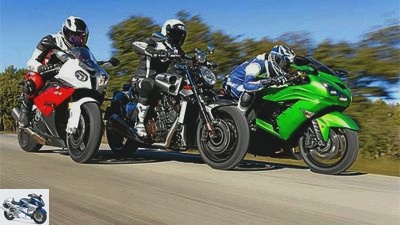
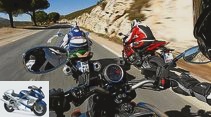

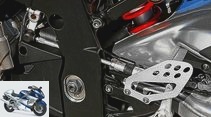
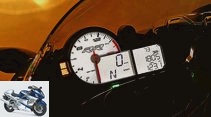
17th photos
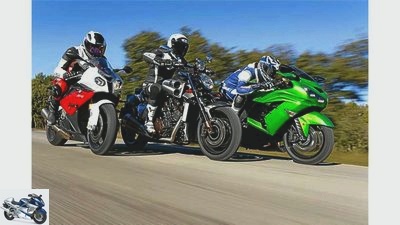
1/17
Completely different concepts – with one thing in common: Apparently unlimited power. BMW S 1000 RR, Yamaha Vmax and Kawasaki ZZR 1400 in a concept comparison.
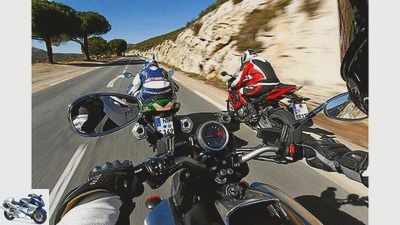
2/17
Kawasaki ZZR 1400 and BMW S 1000 RR followed by Yamaha Vmax.
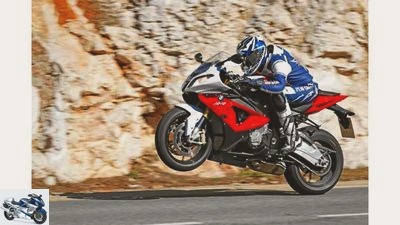
3/17
BMW S 1000 RR: Cheer up: the light BMW with its short wheelbase likes to lift the front wheel when it is at full power.
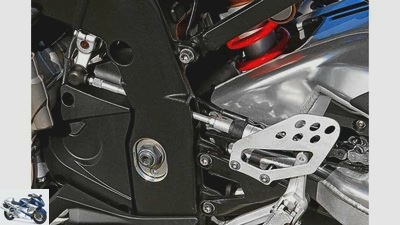
4/17
The automatic gearshift enables lightning-fast gear changes without using the clutch.
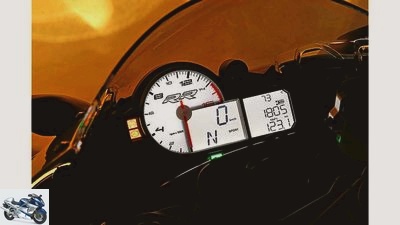
5/17
New, easier to read tachometer, gearshift light and informative display.
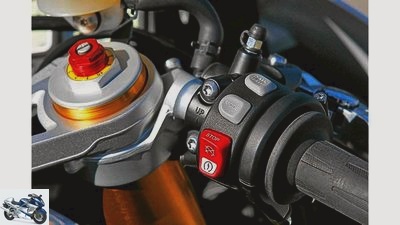
6/17
BWM: Heaters want heated grips, but above all the selection button for the power mode.
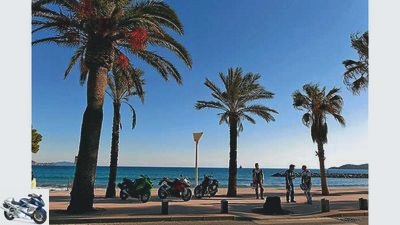
7/17
The concepts are discussed in the shade under palm trees.
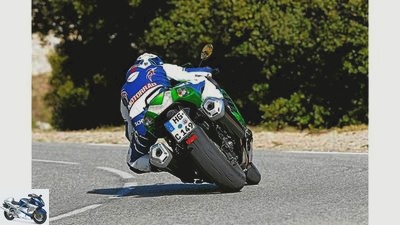
8/17
Kawasaki ZZR 1400: Strangely strong: The Kawasaki, which is quite sporty to move, shows some super athletes the thick stovepipe mufflers.
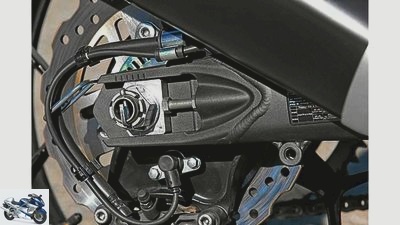
9/17
The swing arm on the Kawa, which is ten millimeters longer, ensures greater driving stability.
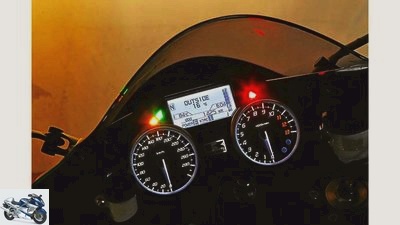
10/17
Analog round clocks and numerous information on the display leave nothing to be desired.
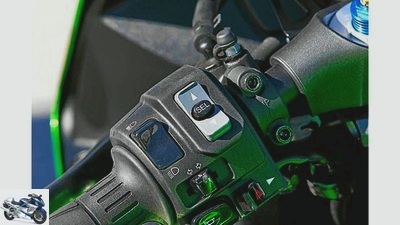
11/17
ZZR 1400: Combination button for traction control (1/2/3) and power mode (full / low).
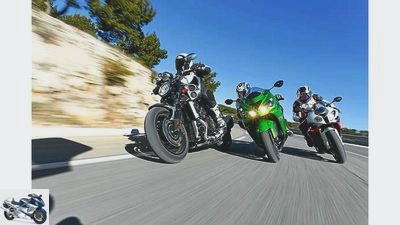
12/17
Yamaha Vmax, Kawasaki ZZR 1400 and BMW S 1000 RR.
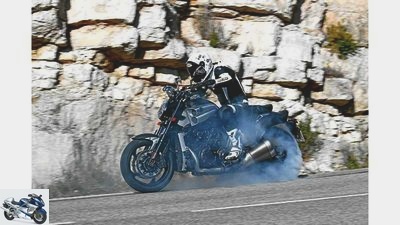
13/17
Yamaha Vmax: Smoking zone: The V4 offers enough steam to create a lot of smoke on the rear wheel when starting.
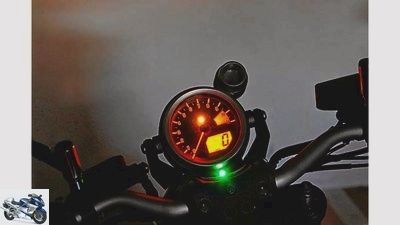
14/17
In the center of the field of vision: tachometer with docked shift light.
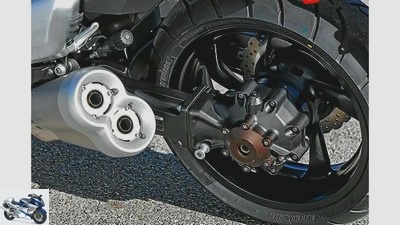
15/17
Growing up to power: the cardan drive shows hardly any drive influences on the Yamaha.
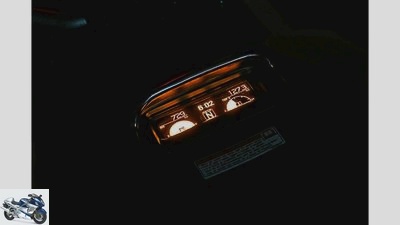
16/17
The displays at the Vmax on the dummy fuel tank are varied, but not in the field of vision.

17/17
Discussion at the end of a test day: The performance characteristics of the three bikes are fascinating – each in its own way.
Concept comparison power bikes
The PS monsters from BMW, Yamaha and Kawasaki in the test
Ready for the ultimate thrill of acceleration, the adrenaline rush at speeds of almost 300 km / h and the lure of power over seemingly endless torque? Welcome to the 200 hp bike club.
We live in a performance society. We are taught this from an early age. Only those who deliver the required performance will achieve something and have access to the clubs of the elite circles. Seen in this light, the career of the freshly redesigned Kawasaki ZZR 1400, which has been boosted to a full 200 hp, can be seen as mapped out – it certainly does not lack performance. The BMW S 1000 RR and Yamaha Vmax have already achieved something: In terms of driving performance and race performance, the 1000 series (still) undisputedly carries the crown of sport bikes. And yamahas Vmax not only holds the MOTORCYCLE sprint record of 2.7 seconds from 0 to 100 km / h, but is undisputedly a living legend as a muscle-packed torque monster and formidable macho bike. But does performance also make you happy? And if so, in what form of administration? In order to examine the different effects of 200 PS, MOTORRAD let the three fundamentally different candidates off the chain for a comparison, which deals more with the respective power experience than with the strict 1000-point grid of usual comparison tests.
Buy complete article

Concept comparison powerbikes
The PS monsters from BMW, Yamaha and Kawasaki in the test
S 1000 RR with the factory specification of 193 HP has not taken the beak too full.
With her power-to-weight ratio of an incredible 1.06 kg / hp, the Bavarian is only slightly above the magical value of 1.0 kg / hp, which was unthinkable some time ago. On paper it is right at the front. But this is where practice counts. At the push of a button, the foursome comes to life with angry growls. The athlete, freshly revised for 2012, received important fine-tuning in many points. Throttle response and pulling power have been improved, the final gear ratio has been shortened a bit, and ABS and DTC (traction control) have also been fine-tuned.
Compared to the two opponents, the four-in-line runs quite rough mechanically, trumpets its power snottily cheekily out into the world, makes no secret of the fact that it was actually born for the racetrack, but still wrests everyday manners. Those who climb the BMW know that they have to crouch in a position that is ergonomically refined and is also suitable for taller drivers. Handlebar offset, footrest position – everything is consistent. The clutch and throttle grip work smoothly, the gentler 2012 version sets itself in motion, and speeds below 5000 rpm are sufficient to warm up. But at the latest during the measurement runs, the battery is fully charged and the full potential is accessed. Engage the clutch with plenty of speed, the driver struggles with the lighter front wheel of the BMW, which is blessed (or punished?) With its short wheelbase, 8000 tours are done in no time, the engine accelerates vigorously. The Bavarian suddenly lifts the front wheel, but the traction control intervenes at lightning speed, briefly reducing performance. Let it stand up to the gearshift speed, thanks to the automatic gearshift (surcharge), a short pull on the gearshift lever is all it takes without using the clutch, and the orgy continues. Second, third, fourth – 200 things are already achieved after 7.1 seconds, the electronics only shut off at a speed of 299 km / h.
Kawasaki ZZR 1400: Strangely strong: The Kawasaki, which is quite sporty to move, shows some super athletes the thick stovepipe mufflers.
More is not possible, no one needs more, one might think after this ride. But success spoils the character – too much performance makes you immodest. The power offered by the S 1000 RR is sufficient anytime, anywhere. Not, however, if you have risen from the Vmax beforehand and have already experienced the famous kick in the back from 2500 tours. It’s not available on the BMW until much later. If you open the gas here at 2500 rpm, let’s say in third gear, you pick up the pace, it is enough for strolling through the town, but no trace of a kick. From a good 4000 tours it gets more energetic and is good for short overtaking sprints, the Bayern four-man pushes harder and harder until he lets the front wheel rise at least in the first two gears at around 8000 rpm. The propulsion in five-digit speed regions is simply breathtaking, the speed madness only ends at a good 14,000 tours. Race ABS and traction control, in a package for 1230 euros, make sense here and prevent rollover forwards or backwards. The freshly revised and significantly strengthened Kawasaki counteracts such dangers with a swing arm that is ten millimeters longer; At 1480, the wheelbase is almost 60 millimeters more than that of the BMW. Long wheelbase, higher weight, and also a new, three-stage traction control – does the Kawasaki keep the front wheel reasonably on the ground when the 200 hp are fully deployed? The increased displacement by means of longer strokes from 1352 to 1441 cubic centimeters, sharper camshafts and various other changes allow the mighty in-line four-cylinder to deliver 206 (MOTORCYCLE record value) instead of the promised 200 (2011 model: 190) hp. A huge announcement. The mighty 1400, however, quickly shows a completely different character than the BMW four: a gentle puss in a green robe here, a nasty grumbler in red and white sports dress there. The sitting position on the ZZR is also moderately sporty – stretched out over the tank, hands on the broad, less cranked handlebars, the driver sits enthroned only discreetly sporty, is even accommodated for long journeys.
Hearty sound or vibrations? Nothing. Only a subtle sound comes from the two huge cannon barrel end pots, vibrations are not disturbing in any speed range. But when it comes to the sausage, the gentle bull lowers his horns to attack. Without a spectacle, the ZZR shoots forward from a standing start, tends to wheelie only discreetly and easily controllably even without traction control and storms to 200 km / h in exactly 7.0 seconds. A little faster than the BMW, but within the range of the measurement tolerance. Quasi a tie, a clear slap would look different. Evenly powerfully pulls the 1400 with force through the rev range from 2000 rpm, at best puts a noticeable shovel on it again at just under 7000 rpm and only rushes into the limiter at 11000 rpm. There can be no more talk of the former weakness of commencement right at the bottom, humming softly, the turbine-like increasing ZZR of the BMW pulls away mercilessly from very low speeds.
Windbreak? Full fairing? Something for wimps, nothing that interests a Vmax driver. Massive, towering, uncovered front – a bare muscle bike made of real shot and grain. Speed is not achieved through aerodynamic tricks, but solely through power. And the Yamaha has plenty of that. Although the mighty V4 engine also nominally delivers “only” a smooth 200 hp, the black Yamaha draws on the full in terms of displacement: almost 1.7 liters displacement and a torque curve that would do credit to a marine diesel speak volumes. And arouse expectations. You reverently take a seat in the soft saddle with the bulging support, your knees spread wide around the sweeping air scoops: the big cinema is about to begin. The sound remains very subtle when strolling at low speeds.
Yamaha Vmax: Smoking zone: The V4 offers enough steam to create a lot of smoke on the rear wheel when starting.
Only when calling up the full power does the pilot reap those angry V4 tubes, brand fervent Hirsch. The upright posture forces you to cling to the high, wide handlebars, the Vmax pulls your arms out – a water ski start from the jetty with a V8 speedboat as the towing vehicle is probably the closest thing to the drama. The Yamaha has ABS as standard, but control of the traction of the rear wheel is the sole responsibility of the driver. And the Vmax, fat 200 rear tire or not, tends to lose that grip and mercilessly dissolve the fat cylinder into smoke at full throttle. The long wheelbase helps to keep the front wheel of the heavy chunk on the ground even when the V4 force is fully deployed, instead the Bridgestone tire erases long black lines on the asphalt in first gear. With a little skill, however, furious sprint times can be conjured up with the 314 kilogram drum. Only the mighty air resistance at high speed lets the Vmax drop somewhat when measuring up to 200 km / h. Up to 100 km / h, it still sets the record with 2.7 seconds. There is also no herb against the V4 bike when it comes to the special torque measurement in the first four gears. Practically from idle, the musclebike makes leaps forward like a big cat jumping on the prey. Of course, the 1700 also benefits from its comparatively short translation. Third gear on the BMW goes up to 220, on the Kawasaki up to 203 and on the Yamaha up to 180 km / h.
Okay, the world is not just made up of traffic light sprint races and 400-meter straights – what about the performance in everyday use, the quality of the chassis, brakes and equipment? The concepts already provide a lot here. The BMW, very super athlete, shines with greedy, in comparison almost nervous handling, precise cornering behavior and hard-hitting brakes with a crisp pressure point. The ABS regulates late in a sporty way and enables radical deceleration in clearly noticeable control processes. The workmanship is at the highest level, the fully adjustable chassis offers a sporty, tight basic set-up – the BMW never becomes a litter.
BMW S 1000 RR: Cheer up: the light BMW with its short wheelbase likes to lift the front wheel when it is at full power.
The Kawasaki, on the other hand, glides smoothly over almost everything that the road surface has to offer. Comfortable, but not spongy – the ZZR offers a great compromise and can be moved surprisingly sportily on a good surface. She circles curves neutrally and very precisely, bending does not require too much effort. Of course, it is not able to follow the more radically designed BMW in quick successive, tight alternating curves. There is almost a tie when it comes to brakes: the Kawa stoppers are not quite as snappy, yet extremely effective and easy to dose, with a finely and reliably state-of-the-art ABS. The three-stage traction control also works flawlessly. The heavy Yamaha does well in an exchange of blows on the country road. The Vmax tamer sits upright in the bulging saddle and, as long as he has finally made the curve behind him without touching down notches or trampling the rear, simply pulls on the cable and dashes away with squeezed roaring – almost regardless of which gear. If, on the other hand, the BMW driver has not engaged the right level and at least high four-digit engine speeds are present, he quickly runs the risk of looking into the two striking twin tailpipes of a card-driven six-centimeter stove. However, the Vmax cannot really keep up with a S 1000 RR that is in motion. The effort required to turn in, the hindquarters too stubborn, the brakes with the radially screwed six-piston monobloc calipers, which are actually known as high-quality, seem too blunt this time. Effect okay, bite and response were better.
Production bikes have never been so strong and yet so tame in everyday life as they are today. Achievement alone does not make you happy, unlike money, it does not calm you either – but once you have experienced it, you will never want to be without it again.
Power and speed
archive
Tensile force diagram.
To the tensile force diagram:
Which forces actually pull the rear wheel and ensure the possible acceleration? How many Newtons does the tire have to bring to the asphalt with as little slip as possible? This value can be calculated and shows which tractive effort is available at which speed in the respective gear. It quickly becomes clear that even the fat 200 mm rear tire of the Vmax cannot help but spin. Over 5000 Newtons at a good 50 km / h and correspondingly low wheel speed overwhelm even the most adhesive rubber. The measured values for the torque from 30 to 100 km / h prove: The BMW, which is designed for high engine speed and has an extremely long gear ratio in first gear, has no chance here, at best it can stand up to the Kawasaki thanks to its low weight. This in turn can only hold a candle to the Yamaha at around 80 km / h – too late to break anything in the measuring range up to 100 km / h. The situation is similar in second and third gear. Only in the fourth (with the Yamaha with only five instead of six gears designed quite long) does the BMW catch up, the Kawasaki pulls with similar force from around 80 km / h, but can no longer make up for the time lost up to this mark.
| BMW | Kawasaki | Yamaha | Top speed * | 299 km / h | 298 km / h | 220 km / h |
| acceleration | 0-100 km / h | 3.2 sec | 2.9 sec | 2.7 sec |
| 0-140 km / h | 4.6 sec | 4.4 sec | 4.4 sec | 0-200 km / h | 7.1 sec | 7.0 sec | 8.3 sec |
| Draft 6th gear: | 60-100 km / h | 3.4 sec | 3.8 sec | 3.1 sec |
| 100-140 km / h | 3.1 sec | 3.1 sec | 3.3 sec | 140-180 km / h | 3.2 sec | 3.1 sec | 3.2 sec |
| 30-100 km / h: | 1st gear | 2.4 sec | 2.2 sec | 2.0 sec |
| 2nd gear | 3.1 sec | 3.1 sec | 2.5 sec | 3rd gear | 4.1 sec | 4.2 sec | 3.5 sec |
| 4th gear | 5.1 sec | 5.3 sec | 4.9 sec |
* Manufacturer information
MOTORCYCLE conclusion
Discussion at the end of a test day: The performance characteristics of the three bikes are fascinating – each in its own way.
Kawasaki ZZR 1400
The lady with style: Kawasaki has created a truly powerful sports tourer that inspires with its cultivated, energetic engine over the entire speed range. The elongated ZZR drives like on rails and gives the ICE under the power bikes.
BMW S 1000 RR
The cheeky racing brat: light and wiry, rough and easy to turn, almost uncompromisingly trimmed for sport. The pressure comes with the speed, the chassis and brakes are almost capable of Grand Prix. ABS and traction control make it easy to deal with almost 200 hp.
Yamaha Vmax
The mighty macho bike: The beefy V4 delivers full thrust from idle, including a smoking rear wheel, drinks properly and roars shamelessly at full power. Not particularly handy, but stable and with a sprinter crown up to 100 km / h. A perfect show bike.
Technical specifications
Yamaha Vmax, Kawasaki ZZR 1400 and BMW S 1000 RR.
| BMW | engine |
| design type | Four-cylinder, four-stroke in-line engine | injection | Ø 48 mm |
| coupling | Multi-disc oil bath clutch (anti-hopping) | Bore x stroke | 80.0 x 49.7 mm |
| Displacement | 999 cm3 | compression | 13.0: 1 |
| power | 142.0 kW (193 hp) at 13,000 rpm | Torque | 112 Nm at 9750 rpm |
| landing gear | frame | Bridge frame made of aluminum |
| fork | Upside-down fork, Ø 46 mm | Steering damper | hydraulic steering damper |
| Brakes v / h | Ø 320/220 mm | Assistance systems | ABS / traction control (1230 euros) |
| bikes | 3.50 x 17; 6.00 x 17 | tires | 120/70 ZR 17; 190/55 ZR 17 |
| Tires | Metzeler Racetec K3 Interact | mass and weight |
| wheelbase | 1423 mm | Steering head angle | 66.0 degrees |
| trailing | 99 mm | Suspension travel v / h | 120/130 mm |
| Seat height ** | 810 mm | Weight with full tank ** | 209 kg |
| Payload ** | 196 kg | Tank capacity / reserve | 17.5 / 4.0 liters |
| Service intervals | 10000 km | price | 16,100 euros |
| Price test motorcycle | 17891 euros *** | Additional costs | 269 euros |
| consumption | Test consumption **** | 6.1 liters / super |
| Range | 287 km |
| Kawasaki | engine |
| design type | Four-cylinder, four-stroke in-line engine | injection | Ø 44 mm |
| coupling | Multi-disc oil bath clutch | Bore x stroke | 84.0 x 65.0 mm |
| Displacement | 1441 cm3 | compression | 12.3: 1 |
| power | 147.0 kW (200 hp) at 10,000 rpm | Torque | 163 Nm at 7500 rpm |
| landing gear | frame | Aluminum monocoque |
| fork | Upside-down fork, Ø 43 mm | Steering damper | – |
| Brakes v / h | Ø 310/250 mm | Assistance systems | ABS / traction control (standard) |
| bikes | 3.50 x 17; 6.00 x 17 | tires | 120/70 ZR 17; 190/50 ZR 17 |
| Tires | Bridgestone S20 “E” | mass and weight |
| wheelbase | 1480 mm | Steering head angle | 67.0 degrees |
| trailing | 94 mm | Suspension travel v / h | 117/122 mm |
| Seat height ** | 800 mm | Weight with full tank ** | 267 kg |
| Payload ** | 176 kg | Tank capacity / reserve | 22.0 liters |
| Service intervals | 6000 km | price | 15595 euros |
| Price test motorcycle | – | Additional costs | 180 euros |
| consumption | Test consumption **** | 6.2 liters / super |
| Range | 355 km |
| Yamaha | engine |
| design type | Four cylinder four stroke 65 degree V engine | injection | Ø 48 mm |
| coupling | Multi-disc oil bath clutch (anti-hopping) | Bore x stroke | 90.0 x 66.0 mm |
| Displacement | 1680 cm3 | compression | 11.3: 1 |
| power | 147.2 kW (200 PS) at 9000 rpm | Torque | 167 Nm at 6500 rpm |
| landing gear | frame | Bridge frame made of cast aluminum |
| fork | Telescopic fork, Ø 52 mm | Steering damper | – |
| Brakes v / h | Ø 320/298 mm | Assistance systems | ABS (standard) |
| bikes | 3.50 x 18; 6.00 x 18 | tires | 120/70 R 18; 200/50 R 18 |
| Tires | Bridgestone BT 028 “G” | mass and weight |
| wheelbase | 1700 mm | Steering head angle | 59.0 degrees |
| trailing | 148 mm | Suspension travel v / h | 120/110 mm |
| Seat height ** | 780 mm | Weight with full tank ** | 314 kg |
| Payload ** | 186 kg | Tank capacity / reserve | 15.0 liters |
| Service intervals | 10000 km | price | 22,995 euros |
| Price test motorcycle | – | Additional costs | 205 euros |
| consumption | Test consumption **** | 8.1 liters / super |
| Range | 185 km |
** MOTORCYCLE measurements; ***Incl. ABS and DTC (1230 euros), automatic gearshift (364 euros) and heated grips (197 euros); **** Mixed consumption from rapid country road and motorway driving;
Related articles
-
Kawasaki ZX-10R and BMW S 1000 RR in a comparison test
www.bilski-fotografie.de 25 pictures www.bilski-fotografie.de 1/25 Let’s first take a look at the new Kawasaki ZX-10R. www.bilski-fotografie.de …
-
Triumph Daytona 675, Kawasaki ZX-6R 636 and Suzuki GSX-R 750 in the test
fact 20th photos fact 1/20 Super athletes with less than 1000cm³ in the comparison test. Suzuki GSX-R 750, Kawasaki ZX-6R 636 and Triumph Daytona 675….
-
Yamaha FJR 1300 Tourer in the test
fact 38 pictures fact 1/38 Yamaha FJR 1300 in the top test. fact 2/38 Yamaha FJR 1300 in the top test. fact 3/38 Yamaha FJR 1300 in the top test. fact 4/38 Yamaha FJR …
-
Kawasaki Ninja H2 in the top test
Bilski 26 pictures Bilski 1/26 Mi 218 hp, the H2 is the most powerful bike on the MOTORRAD test bench to date. Bilski 2/26 The polished stainless steel elbows form …
-
Artist 38 photos Artist 1/38 …and has to be careful that he does not get sick with constant changes of lean angle. Artist 2/38 The machine comes…
-
Ducati 1299 Panigale S and Kawasaki Ninja H2 in comparison test
31 pictures 1/31 Left in the picture 197 HP and 145 Nm (Ducati 1299 Panigale S), on the right there are 200 HP and 133 Nm (Kawasaki Ninja H2) ….
-
fact 30 pictures fact / Joachim Schahl 1/30 There is movement in the middle class. The Yamaha MT-09 is ready with a well-presented three-cylinder, which …
-
Jahn 35 pictures Jahn 1/35 Husqvarna TC 250 R in the motocross comparison test. Jahn 2/35 Yamaha YZ 250 F in the motocross comparison test. Jahn 3/35 Husqvarna TC …
-
MX1 crossers from Honda, Kawasaki, KTM, Suzuki and Yamaha put to the test
Jahn 16 pictures Jahn 1/16 In the test: Honda CRF 450 R, Yamaha YZ 450 F, Suzuki RM-Z 450, KTM 350 SX-F, Kawasaki KX 450 F and KTM 450 SX-F. Jahn 2/16 KTM 350 …
-
Superbikes put to the test: BMW S 1000 RR, Kawasaki ZX -10 R and MV Agusta F4 RR
fact 18th photos fact 1/18 What counts on the road is all the more important on the Nordschleife: a swelling torque curve and an uncomplicated,…